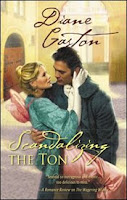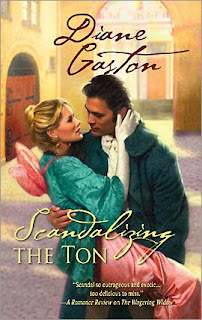 Yes, here’s Diane Gaston, to talk about her newest release Scandalizing the Ton, and one lucky person will win a signed copy of the book–your comment or question enters you into the contest. So chat away and have fun.
Yes, here’s Diane Gaston, to talk about her newest release Scandalizing the Ton, and one lucky person will win a signed copy of the book–your comment or question enters you into the contest. So chat away and have fun.
 4 Stars! In this spin-off of The Vanishing Viscountess, Gaston deftly portrays the era and brings back previous characters. Her sensitive, compassionate and sensual romance shows how the power of love can overcome adversity. — Joan Hammond, Romantic Times BOOKreviews
4 Stars! In this spin-off of The Vanishing Viscountess, Gaston deftly portrays the era and brings back previous characters. Her sensitive, compassionate and sensual romance shows how the power of love can overcome adversity. — Joan Hammond, Romantic Times BOOKreviews
Scandalizing the Ton has everything you want in a romance novel – love and passion, scandal and secrets….— Debby Guyette, Cataromance
Tell us about Scandalizing the Ton (and congrats on the great reviews!).
Scandalizing the Ton is my Regency Paparazzi story, my idea of what it would be like for a Regency lady to be the victim of the historical equivalent of the media frenzy we’ve seen around celebrities like Paris Hilton and Britney Spears. Or Anna Nicole Smith.
Here is the backcover blurb: Lady Wexin, once the ton’s foremost beauty, has been abandoned by her family and friends, and creditors hound her. Her husband’s scandalous death has left her impoverished and the gossip-mongering press is whipped into a frenzy of speculation when it becomes clear the widow is with child. Who is the father? Only one man knows: Adrian Pomroy, Viscount Cavanley. He has cultivated the reputation of a rake, but in truth yearns for something useful to do. Delicate beauty Lydia Wexin could pose an intriguing and stimulating challenge.
Your hero, Pom, appeared in an earlier book. (Is that really his nickname?) When you created him, did you anticipate that he would have his own story?
 Sigh. I didn’t realize when Pomroy first appeared in Innocence and Impropriety that “Pom,” as his friend Tanner called him, was a derogatory Australian term for a British person. Pomroy was a minor character and I had no plans to make him a hero, even when he was mentioned in The Vanishing Viscountess, Tanner’s story. When I selected Lydia as my next heroine, though, Pomroy was the perfect hero for her because of his reputation and his connection to Tanner. I couldn’t go through the book calling him “Pom” (my British editor told me) so I gave him a courtesy title and contrived to have Lydia call him Adrian, which I thought was a pretty cool hero name. He’s Adrian throughout the book—except to Tanner.
Sigh. I didn’t realize when Pomroy first appeared in Innocence and Impropriety that “Pom,” as his friend Tanner called him, was a derogatory Australian term for a British person. Pomroy was a minor character and I had no plans to make him a hero, even when he was mentioned in The Vanishing Viscountess, Tanner’s story. When I selected Lydia as my next heroine, though, Pomroy was the perfect hero for her because of his reputation and his connection to Tanner. I couldn’t go through the book calling him “Pom” (my British editor told me) so I gave him a courtesy title and contrived to have Lydia call him Adrian, which I thought was a pretty cool hero name. He’s Adrian throughout the book—except to Tanner.
How would you define your books?
 My niche at Harlequin Historical is to write about the Regency Underworld, the darker, grittier side of the Regency. The Mysterious Miss M, my first book, set the tone with its heroine who had been forced into prostitution. Since then I’ve tries to focus on the seamier side of gambling, of the theatre, and I also sent a marquess on the run with a beautiful fugitive. Scandalizing the Ton examines the darker side of the press during the Regency.
My niche at Harlequin Historical is to write about the Regency Underworld, the darker, grittier side of the Regency. The Mysterious Miss M, my first book, set the tone with its heroine who had been forced into prostitution. Since then I’ve tries to focus on the seamier side of gambling, of the theatre, and I also sent a marquess on the run with a beautiful fugitive. Scandalizing the Ton examines the darker side of the press during the Regency.
Do you find US and UK readers have different demands or expectations, and how do you meet both?
I mostly leave this up to my editors to help me get the varying expectations correct. (See my answer above about “Pom.” – there’s a lot I don’t know about the UK !). I do believe that the UK readers would want me to get their history and their geography correct. As a result, I try to be as accurate as I can be. Mostly, though, I believe both US and UK readers primarily want a good story. That is what I try to deliver.
How did you start this book: with the characters, or with the idea of a book about paparazzi in the Regency?
 I started with the character of Lydia , who had to suffer for the sins of her former husband. At the end of The Vanishing Viscountess I’d left poor Lydia , totally innocent of any wrongdoing, in a very unhappy situation. She deserved a happy ending and someone like Pomroy ..er … Adrian … who was a light-hearted charmer, seemed perfect for her.
I started with the character of Lydia , who had to suffer for the sins of her former husband. At the end of The Vanishing Viscountess I’d left poor Lydia , totally innocent of any wrongdoing, in a very unhappy situation. She deserved a happy ending and someone like Pomroy ..er … Adrian … who was a light-hearted charmer, seemed perfect for her.
I originally focused on the pregnancy aspect of the story and had a villain who, in the end, abducted her baby. My editor accepted it but added, “Diane, do you realize you have ended the last three books with an abduction?”
Acck! (Amazing how blind one can be to such things) It was back to the drawing board for me. The paparazzi element had always been part of the story, but my friend Julie suggested I make the press the “villain.” Once she said that, I knew I had my story, a story I could put my heart into.
What’s your favorite scene?
Probably the initial scene when Adrian is caring for Lydia and it leads to lovemaking. I like to write these premature love scenes between two people who are obviously right for each other but who don’t even know each other yet. It’s like a foreshadowing of what is meant to be between them.
What was the most troublesome scene to write?
Oh, gosh. I can’t think of a troublesome scene (or one more troublesome than all the others). What was tricky was sustaining the love story between Lydia and Adrian when they really were not together for a significant part of the book. I did that by keeping them in each other’s thoughts and by the scene when Lydia sees Pomroy…er Adrian …pass by in a carriage.
What’s next?
The very next thing is my novella in the anthology I’m doing with Amanda and Deb Marlowe. We had such fun plotting this together. The anthology is called The Diamonds of Welbourne Manor, to be released May 2009, and it will be a featured book in Harlequin’s Diamond Jubilee. Mine is the first story and here is the set-up:
When the Duke of Manning ran off with Lady Linwall it had been the scandal of its day. Did they care? Not at all. Their home, Welbourne Manor, soon housed a happy miscellany of his and theirs—but not hers, not the young son she left behind. Now all the children are grown, this estranged son is on their doorstep, and all their lives are about to change.
There are more books coming, too, but you’ll hear more about them a bit later. Scandalizing the Ton really brings to an end the series of books that began with The Mysterious Miss M, which makes me a little sad, but I ran out of characters and I was coming perilously close to the end of the Regency era. I have a new trilogy planned and this is what you’ll hear more about as time goes on.
And you can always check my website!
Ask away… your question or comment enter you into a contest for a signed copy of Scandalizing the Ton.
p.s. sneaky promo from Janet, who’s guest blogging over at Historical Romance UK today. Come on over and chat!
 It is Columbus Day, a federal holiday here, but one lots of employers trade for the day after Thanksgiving.
It is Columbus Day, a federal holiday here, but one lots of employers trade for the day after Thanksgiving.After he robbed the cargo of a Mayan trader, he made this comment:
 It has to do with a posthumous child, the unborn child of a deceased earl, in this case.
It has to do with a posthumous child, the unborn child of a deceased earl, in this case.Here’s the display of Harlequin Historicals
And here is a photo of a whole shelf. Can you see Scandalizing the Ton in there? (this is a little like Where’s Waldo?)
Here’s the photo of the whole book department there, which is a large one.















